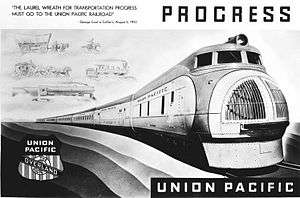M-10001

The Union Pacific Railroad's M-10001 was a record breaking diesel-electric streamliner train built in late 1934 by Pullman-Standard with an engine from General Motors Electro-Motive Corporation and General Electric generator, control equipment and traction motors. It was the UP's second streamliner after the pioneering M-10000, the first equipped with a diesel engine and was a much longer train (six cars) than its three-car predecessor. All cars were articulated—trucks were shared between each car. It was delivered on October 2, 1934, and was used for display, test and record-setting runs for the next two months before being returned to Pullman-Standard for an increase in its power and capacity, following which it was placed into service as the City of Portland train.
Record-setting run
In October 1934 the M-10001, known as the "Canary Bolt" and still in its original 900 hp (670 kW) incarnation, set an as-yet unbroken record of 57 hours from coast to coast of the United States, leaving Los Angeles at 10 PM on the 22nd and arriving Grand Central Terminal at 9:55 AM on the 25th.[1] When placed in service as the City of Portland the train reduced the Chicago, Illinois to Portland, Oregon schedule from 58 hours to 40 hours without any upgrades to track or other facilities.
Technical details
When built, the M-10001 was a fully articulated six-car train, 376 ft (115 m) in length, comprising a 48 ft (15 m) turret-cab power car, a Railway Post Office/baggage car, three Pullman sleeping cars, and a rounded-tail coach/buffet/observation car. It was powered by a 900 hp (670 kW) V12 version of the Winton 201-A engine, driving the first two trucks of the train. Pre-service testing revealed that the original motor was underpowered for the train's intended service, and that the truck design resulted in unstable oscillations at high speeds. Those problems were remedied with a larger motor and lengthened trucks.[2] Martin P. Blomberg carried that experience with truck design to the Electro-Motive Corporation, reflected in the design of their E series locomotives.
The rebuilding lengthened the entire train to 455 feet (139 m) and seven cars. The power car had 12 ft (3.7 m) added to accommodate a larger, 1,200 hp (890 kW) V16 Winton diesel engine. The RPO/baggage car was lengthened by eight feet (2.4 m) to take a steam generator for train heating, and was followed by the addition of a diner/lounge car.
The 1,200 hp (890 kW) Winton Diesel motor was the most powerful Diesel motor used in a passenger train until the postwar era. It was installed in locomotive units built during 1935-36, after which twin motor designs became preferred.
Service life
The rebuilt train was re-delivered on May 23, 1935, and after some test runs was dedicated as the first City of Portland on June 5 at the Portland Rose Festival, entering service between Portland, Oregon and Chicago the following day. It remained in that service until the end of 1937 when it was replaced in service by the M-10002 trainset, reassigned from the City of Los Angeles. After serving on the Portland-Seattle run it was retired in June 1939, as the imperative to increase the power of the City of Denver trains drove Union Pacific to cannibalize M-10001 and M-10004. By December the diesel engine, generator, trucks, and the steam generator from the RPO/baggage car were removed and installed in a new carbody to become the third power unit on the CD-07 set for the City of Denver. The remainder of the train was stored until August 13, 1941, when it was sold for scrap.
References
- ↑ "Coast-Chicago Record Beaten by Streamliner". The Milwaukee Journal. 24 October 1934. Retrieved 27 March 2012.
- ↑ "Latest Streamline Train Has Giant Engine" Popular Mechanics, December 1934
Further reading
- Pinkepank, Jerry A. (1973). The Second Diesel Spotter's Guide. Kalmbach Publishing Co., Milwaukee, WI. ISBN 0-89024-026-4.
- Strack, Don (2001) Union Pacific Diesel Story, 1934–1982, Part I. Retrieved on December 25, 2004.
- Kratville, William W., and Ranks, Harold E., The Union Pacific Streamliners, 1974
External links
-
 Media related to M-10001 at Wikimedia Commons
Media related to M-10001 at Wikimedia Commons